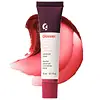Glossier Balm Dotcom Versus Glossier Ultralip
What's inside
What's inside
 Key Ingredients
Key Ingredients

 Benefits
Benefits

 Concerns
Concerns

 Ingredients Side-by-side
Ingredients Side-by-side

Petrolatum
EmollientRicinus Communis Seed Oil
MaskingBeeswax
Emulsion StabilisingLanolin
EmollientAroma
Theobroma Grandiflorum Seed Butter
Skin ConditioningOryza Sativa Bran Extract
Skin ConditioningHelianthus Annuus Extract
EmollientRosmarinus Officinalis Leaf Extract
AntimicrobialTocopheryl Acetate
AntioxidantTocopherol
AntioxidantBHT
AntioxidantStevia Rebaudiana Leaf/Stem Extract
MaskingBenzyl Benzoate
AntimicrobialLimonene
PerfumingCitral
PerfumingCitronellol
PerfumingLinalool
PerfumingIron Oxides
CI 77491
Cosmetic ColorantCI 77499
Cosmetic ColorantCI 17200
Cosmetic ColorantCI 45410
Cosmetic ColorantCI 73360
Cosmetic ColorantCI 15985
Cosmetic ColorantPetrolatum, Ricinus Communis Seed Oil, Beeswax, Lanolin, Aroma, Theobroma Grandiflorum Seed Butter, Oryza Sativa Bran Extract, Helianthus Annuus Extract, Rosmarinus Officinalis Leaf Extract, Tocopheryl Acetate, Tocopherol, BHT, Stevia Rebaudiana Leaf/Stem Extract, Benzyl Benzoate, Limonene, Citral, Citronellol, Linalool, Iron Oxides, CI 77491, CI 77499, CI 17200, CI 45410, CI 73360, CI 15985
Polybutene
Bis-Behenyl/Isostearyl/Phytosteryl Dimer Dilinoleyl Dimer Dilinoleate
EmollientSimmondsia Chinensis Seed Oil
EmollientDiisostearyl Malate
EmollientPolyethylene
AbrasiveTriisostearyl Citrate
EmollientC12-15 Alkyl Lactate
EmollientEuphorbia Cerifera Wax
Pentaerythrityl Tetraisostearate
EmollientTrimethylolpropane Triisostearate
EmollientLimnanthes Alba Seed Oil
Skin ConditioningOctyldodecanol
EmollientTridecyl Trimellitate
EmollientSucrose Acetate Isobutyrate
Synthetic Fluorphlogopite
Sodium Hyaluronate
HumectantHelianthus Annuus Seed Wax
Skin ConditioningCitrullus Lanatus Seed Oil
EmollientTribehenin
EmollientRicinus Communis Seed Oil
MaskingTocopheryl Acetate
AntioxidantButyrospermum Parkii Nut Extract
EmollientHydrated Silica
AbrasiveLecithin
EmollientEthylhexyl Palmitate
EmollientCaprylic/Capric Triglyceride
MaskingPalmitoyl Tripeptide-1
Skin ConditioningLactic Acid
BufferingAscorbyl Palmitate
AntioxidantPentaerythrityl Tetra-Di-T-Butyl Hydroxyhydrocinnamate
AntioxidantTocopherol
AntioxidantSorbitan Oleate
EmulsifyingSorbitan Isostearate
EmulsifyingCaprylyl Glycol
EmollientCI 15850
Cosmetic ColorantTitanium Dioxide
Cosmetic ColorantIron Oxides
CI 42090
Cosmetic ColorantCI 45410
Cosmetic ColorantCI 19140
Cosmetic ColorantCI 15985
Cosmetic ColorantPolybutene, Bis-Behenyl/Isostearyl/Phytosteryl Dimer Dilinoleyl Dimer Dilinoleate, Simmondsia Chinensis Seed Oil, Diisostearyl Malate, Polyethylene, Triisostearyl Citrate, C12-15 Alkyl Lactate, Euphorbia Cerifera Wax, Pentaerythrityl Tetraisostearate, Trimethylolpropane Triisostearate, Limnanthes Alba Seed Oil, Octyldodecanol, Tridecyl Trimellitate, Sucrose Acetate Isobutyrate, Synthetic Fluorphlogopite, Sodium Hyaluronate, Helianthus Annuus Seed Wax, Citrullus Lanatus Seed Oil, Tribehenin, Ricinus Communis Seed Oil, Tocopheryl Acetate, Butyrospermum Parkii Nut Extract, Hydrated Silica, Lecithin, Ethylhexyl Palmitate, Caprylic/Capric Triglyceride, Palmitoyl Tripeptide-1, Lactic Acid, Ascorbyl Palmitate, Pentaerythrityl Tetra-Di-T-Butyl Hydroxyhydrocinnamate, Tocopherol, Sorbitan Oleate, Sorbitan Isostearate, Caprylyl Glycol, CI 15850, Titanium Dioxide, Iron Oxides, CI 42090, CI 45410, CI 19140, CI 15985
 Reviews
Reviews

Ingredients Explained
These ingredients are found in both products.
Ingredients higher up in an ingredient list are typically present in a larger amount.
Ci 15985 is a dye made from petroleum. It is synthetically created and approved by the FDA for use in foods and cosmetics.
The color of this dye is orange/yellow.
This ingredient can be found in makeup, sun care, and skincare.
Learn more about CI 15985CI 45410 is a synthetic red-pigment and dye.
It often goes by both Red 28 or Red 27; manufacturers label both ingredients as CI 45410.
This dye is commonly found in makeup because it imparts a vivid color. Some types of this dye change color based on pH level and interaction with moisture:
Your skin has a natural pH of around 4.5 - 5.5.
According to the FDA, CI 45410 is not permitted for use in eye products.
Red 27 is a flourescein dye and commonly used as a fluorescent tracer in medicine.
Learn more about CI 45410Ricinus Communis Seed Oil is the INCI name for castor oil.
Castor Oil helps moisturize the skin. It is rich in a fatty acid called ricinoleic acid. This fatty acid helps prevent moisture loss on the skin. This helps keep your skin soft and hydrated. Ricinoleic acid also has anti-inflammatory and pain reducing properties.
Besides hydrating the skin, castor oil is also used to hydrate hair. By keeping the hair shaft moisturized, breakage is decreased. More studies are needed to show castor oil's effective on stimulating hair growth.
Castor oil is created by cold-pressing castor seeds and then purifying the oil with heat. It was used in Ancient Egypt as fuel in lamps and to help treat eye irritation.
The term 'fragrance' is not regulated in many countries. In many cases, it is up to the brand to define this term. For instance, many brands choose to label themselves as "fragrance-free" because they are not using synthetic fragrances. However, their products may still contain ingredients such as essential oils that are considered a fragrance.
Learn more about Ricinus Communis Seed OilTocopherol (also known as Vitamin E) is a common antioxidant used to help protect the skin from free-radicals and strengthen the skin barrier. It's also fat soluble - this means our skin is great at absorbing it.
Vitamin E also helps keep your natural skin lipids healthy. Your lipid skin barrier naturally consists of lipids, ceramides, and fatty acids. Vitamin E offers extra protection for your skin’s lipid barrier, keeping your skin healthy and nourished.
Another benefit is a bit of UV protection. Vitamin E helps reduce the damage caused by UVB rays. (It should not replace your sunscreen). Combining it with Vitamin C can decrease sunburned cells and hyperpigmentation after UV exposure.
You might have noticed Vitamin E + C often paired together. This is because it is great at stabilizing Vitamin C. Using the two together helps increase the effectiveness of both ingredients.
There are often claims that Vitamin E can reduce/prevent scarring, but these claims haven't been confirmed by scientific research.
Learn more about TocopherolTocopheryl Acetate is AKA Vitamin E. It is an antioxidant and protects your skin from free radicals. Free radicals damage the skin by breaking down collagen.
One study found using Tocopheryl Acetate with Vitamin C decreased the number of sunburned cells.
Tocopheryl Acetate is commonly found in both skincare and dietary supplements.
Learn more about Tocopheryl AcetateThis ingredient is a combination of red, black, and yellow iron oxide pigments. This combination of colors is usually found in foundation, because it results in a "skin" color.